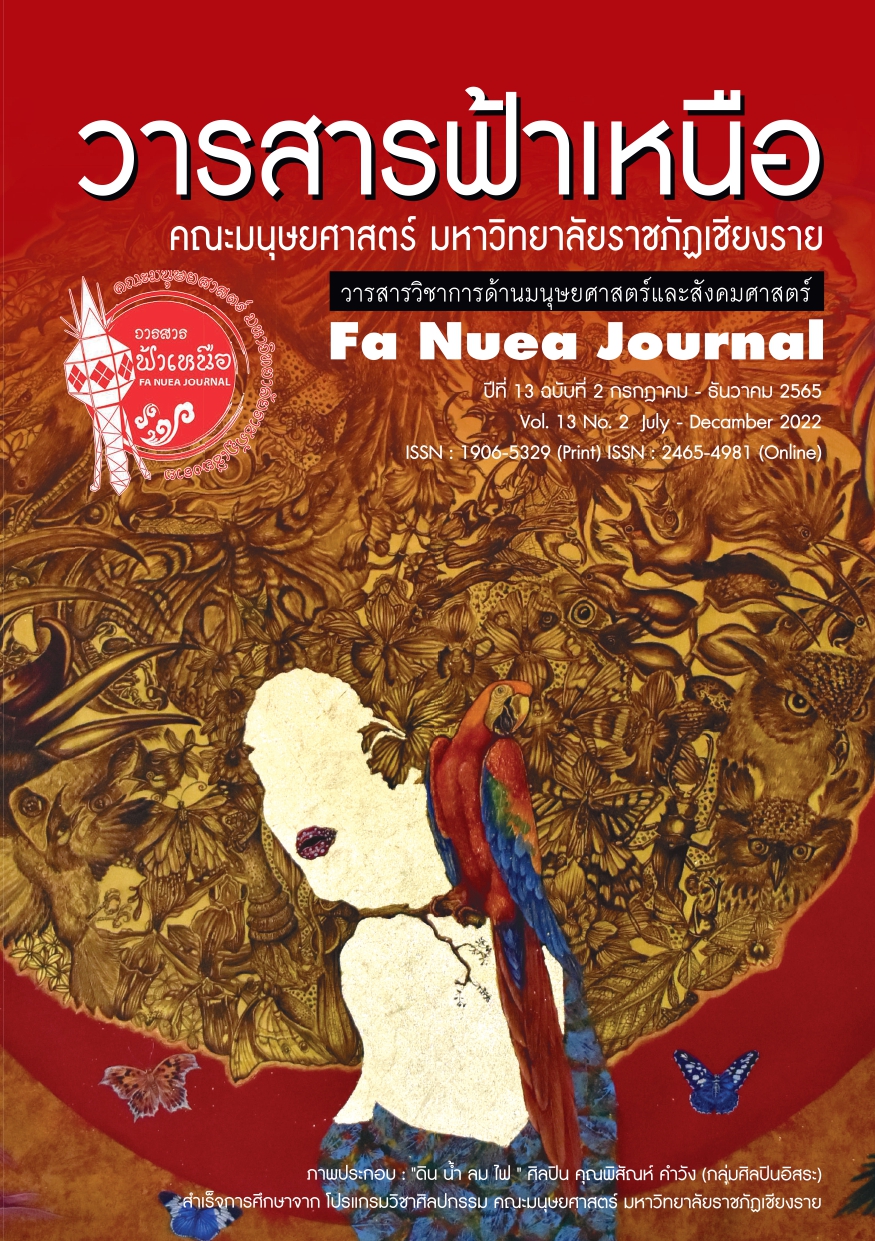Analysis of Cohesion in the Literary Work of Dek Ban Doi’s Mala Khamchan
Main Article Content
Abstract
This study aimed to study the cohesion in the literary work of Dek Ban Doi’s Mala Khamchan and to analyze the effects of Mala Khamchan's cohesion in the literary work entitled “Dek Ban Doi” of Mala Khamchan, by using the concept of cohesion that the researcher synthesized from cohesion concept of cohesion of Amara's Prasit Ratasin (2009) and Warawat Sriyaphai (2020) based on the six types of cohesion concepts: reference, repetition, ellipsis, substitution, lexicon, and conjunction. Content-descriptive analysis and tabular presentation were used to analyze the data. The result showed that there were six types of cohesion; reference, repetition, ellipsis, substitution, lexicon, and conjunction. The most cohesion used was pronominal reference, personal reference used as pronoun reference. There were 2 characteristics of the cohesion usage; 1) the language expressions, which is clear and easy to understand, and the beautiful and elegant language; and 2) the overall uses of language that expressed the identity of the cohesive language in the literary work of Mala Khamchan's Dek Ban Doi, where there was a lot of cohesive language using and the comparative reference in many paces of the text.
Article Details

This work is licensed under a Creative Commons Attribution-NonCommercial-NoDerivatives 4.0 International License.
Articles, information, content, pictures, etc. which have been published in Fa Nuea Journal, are copyright of Fa Nuea Journal. If any person or party wishes to disseminate all or part of it or take any action must be referenced. Do not use for commercial purposes and do not modify (CC-BY-NC-ND). For further details, please access at Attribution-NonCommercial-NoDerivatives 4.0 International (CC BY-NC-ND 4.0)
References
ชื่นจิตต์ อธิวรกุล. (2553). การเชื่อมโยงความและความเกี่ยวข้องของเรื่องที่สนทนาในการสนทนา แบบเป็นกันเองระหว่างเพศชายและเพศหญิง [วิทยานิพนธ์ปริญามหาบัณฑิต]. มหาวิทยาลัยศรีนครินทรวิโรฒ.
ฐะปะนีย์ นาครทรรพ. (2544). ปัจจัยที่มีผลต่อพัฒนาการของวรรณคดีไทย. ใน มหาวิทยาลัยสุโขทัยธรรมาธิราช, เอกสารการสอนชุดวิชาพัฒนาการวรรณคดีไทย เล่ม 2 หน่วยที่ 14. (น. 875-951). สำนักพิมพ์มหาวิทยาลัยสุโขทัยธรรมาธิราช.
ธัญญา สังขพันธานนท์. (2539). วรรณกรรมวิจารณ์. สำนักพิมพ์นาคร.
ปาณิสรา เบี้ยมุกดา. (2550). การเชื่อมโยงความในพระราชนิพนธ์เสด็จประพาสต่างประเทศของพระบาทสมเด็จพระจุลจอมเกล้าเจ้าอยู่หัว [วิทยานิพนธ์ปริญามหาบัณฑิต]. มหาวิทยาลัยธรรมศาสตร์.
พรพรหม บุญถนอม. (2551). วิธีการนำเสนอภาพสังคมวัฒนธรรมท้องถิ่นภาคเหนือของไทย ในนวนิยายของมาลา คำจันทร์ [วิทยานิพนธ์ปริญญามหาบัณฑิต]. มหาวิทยาลัยรามคำแหง.
ภัทรวดี อุทธา. (2555). การเชื่อมโยงความในวรรณกรรมท้องถิ่นอีสาน เรื่องขูลูนางอั้ว [วิทยานิพนธ์ปริญามหาบัณฑิต]. มหาวิทยาลัยเกษตรศาสตร์.
มาลา คำจันทร์. (2557). เด็กบ้านดอย. (พิมพ์ครั้งที่ 6). สำนักพิมพ์เคล็ดไทย.
วรวรรธน์ ศรียาภัย. (2563). หน่วยที่ 6 เรื่องที่ 6.2.2 การเชื่อมโยงความ. ใน พรพิมล นุ่นปาน (บรรณาธิการผู้ช่วย), เอกสารการสอนชุดวิชาลักษณะภาษาไทย หน่วยที่ 1-7. (น. 55-77). สำนักพิมพ์มหาวิทยาลัยสุโขทัยธรรมาธิราช.
สมทรง บุรุษพัฒน์. (2537). วจนะวิเคราะห์: การวิเคราะห์ภาษาระดับข้อความ. สถาบันวิจัยภาษาและวัฒนธรรมเพื่อพัฒนาชนบทมหาวิทยาลัยมหิดล.
สันติวัฒน์ จันทร์ใด. (2550). การใช้วัฒนธรรมท้องถิ่นภาคเหนือในการสร้างสรรค์ นวนิยายของ มาลา คำจันทร์ [วิทยานิพนธ์ปริญญามหาบัณฑิต]. จุฬาลงกรณ์มหาวิทยาลัย.
สุนีย์ ลีลาพรพินิจ. (2547). ลักษณะการเชื่อมโยงความที่ปรากฏในสามก๊กฉบับเจ้าพระยาคลัง (หน) [วิทยานิพนธ์ปริญญามหาบัณฑิต]. มหาวิทยาลัยธรรมศาสตร์.
อมรา ประสิทธิ์รัฐสินธุ์. (2552). บทที่ 5 สัมพันธสาร. ใน วิจินตน์ ภาณุพงศ์ และคณะ (บ.ก.), บรรทัดฐานภาษาไทย เล่ม 3: ชนิดของคำ วลี ประโยคและสัมพันธสาร (น. 117-144). สถาบันภาษาไทย สำนักวิชาการและมาตรฐานการศึกษา สำนักงานคณะกรรมการการศึกษาขั้นพื้นฐาน กระทรวงศึกษาธิการ.


